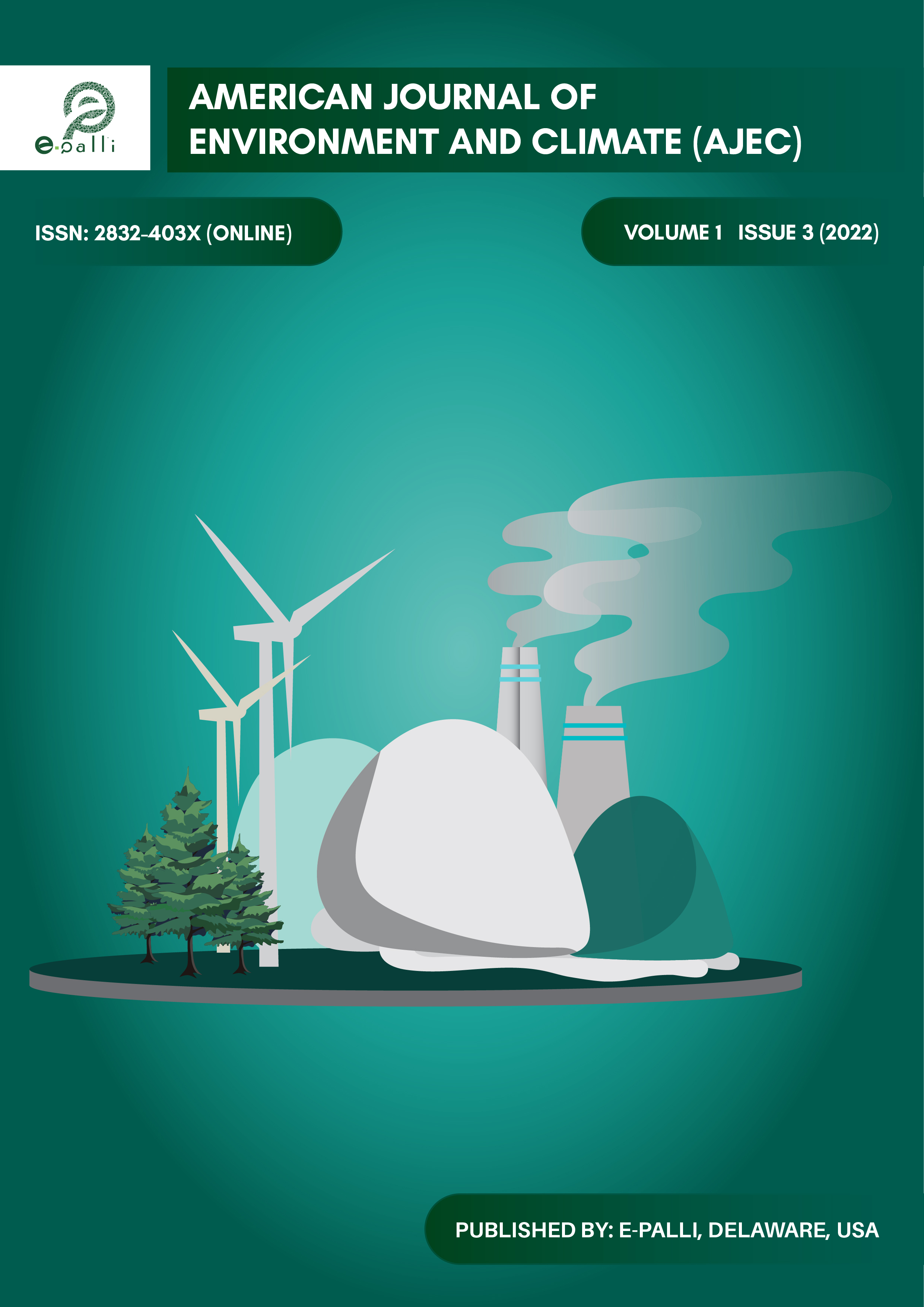Entity-level Greenhouse Gas Emission of University of Science and Technology of Southern Philippines-Oroquieta
DOI:
https://doi.org/10.54536/ajec.v1i3.665Keywords:
Carbon Dioxide Emission, Entity-Level Greenhouse Gas Emission, Greenhouse Gas AccountingAbstract
Presently, climate change is still one of the pressing environmental concerns in the world generally caused by greenhouse gas emission. Among the greenhouse gases emitted by various sources, carbon dioxide contributes largely to the emission. In this study, the entity-level greenhouse gas emission of the University of Science and Technology of Southern Philippines-Oroquieta for Year 2020 was estimated following the 2006 IPCC Guidelines for National Greenhouse Gas Inventories. Based on the results, emission from mobile combustion sources was estimated to be 0.0895 tCO2e while emission from stationary combustion sources was 0.139 tCO2e yielding a total GHG emission for Scope 1 of 0.2285 tCO2e. Moreover, the electricity consumption of the campus which corresponds to the Scope 2 emission yielded 24.7135 tCO2 constitutes largely to the overall greenhouse gas emission. This might be due to the flexible learning modality where faculty members stay at their respective offices to conduct their classes hence regularly utilizing electricity from air conditioners, computers, mobile phones and others.
Downloads
References
Arneth, A., Barbosa, H., Benton, T., Calvin, K., Calvo, E., Connors, S., Haughey, E. (2019). IPCC Special Report on Climate Change, Desertification, Land Degradation, Sustainable Land Management, Food Security, and Greenhouse gas fluxes in Terrestrial Ecosystems. IPCC.
Bollettino, V., Alcayna-Stevens, T., Sharma, M., Dy, P., Pham, P., & Vinck, P. (2020). Public perception of climate change and disaster preparedness: Evidence from the Philippines. Climate Risk Management, 30. doi:https://doi.org/10.1016/j.crm.2020.100250
Climate Watch. (2020). World Resources Institute. (World Resources Institute Climate Analysis Indicators Tool) Retrieved September 30, 2020, from www.climatewatchdata.org
Climatewatch. (2022). Historical GHG Emissions. Retrieved February 9, 2022, from World Resources Institute Climate Analysis Indicators Tool. https://www.climatewatchdata.org/ghg-emissions?breakBy=gas&end_year=2018§ors=total-excluding-lucf&start_year=1990
Congressional Policy and Budget Research Department. (2021). GLOBAL CLIMATE RISK INDEX 2021 . GovPH.
Department of Energy. (2020). 2015-2017 National Grid Emission Factor (NGEF). Retrieved August 18, 2021, from GovPH: https://www.doe.gov.ph/electric-power?q=electric-power/ngef
Domke, G. M., Oswalt, S. N., Walters, B. F., & Morin, R. S. (2020, October 6). Tree planting has the potential to increase carbon sequestration capacity of forests in the United States. Proceedings of the National Academy of Sciences of the United States of America. https://doi.org/10.1073/pnas.2010840117
Durana, A. L. (2017, February 2). Towards a Low-carbon Economy for the Philippines. Retrieved October 21, 2020, from National Academy of Science and Technology Philippines. https://nast.ph/index.php/13-news-press-releases/301-towards-a-low-carbon-economy-for-the-philippines
Friedlingstein, P., Jones, M. W., O’Sullivan, M., Andrew, R. M., Hauck, J., Peters, G. P., . . . Jackson, R. (2019). Global Carbon Budget 2019. Earth System Science Data, 1783–1838.
IPCC. (2014). Climate Change 2014: Synthesis Report. In T. C. Team, R. K. Pachauri, & L. Meyer (Ed.), Contribution of Working Groups I, II, and III to the Fifth Assessment Report of he Intergorvernmental Panel on Climate Change (p. 151). Switzerland: Intergovernmental Panel on Climate Change.
Jackson, R. B., Friedlingstein, P., Andrew, R. M., & Canadell, J. G. (2019). Persistent fossil fuel growth threatens the Paris Agreement and planetary health. Environmental Research Letters, 121001.
Locatelli, B. (2011, August). Synergies between adaptation and mitigation in a nutshell.
Ma, Q. (1998, March). Greenhouse Gases: Refining the Role of Carbon Dioxide. Retrieved November 14, 2020, from National Aeronautics and Space Administration Goddard Institute for Space Studies. https://www.giss.nasa.gov/research/briefs/ma_01/
Maizland, L. (2021, November 17). Global Climate Agreements: Successes and Failures. Retrieved February 1, 2022, from https://www.cfr.org/backgrounder/paris-global-climate-change-agreements
Montagnini, F., & Nair, P. R. (2004). Carbon sequestration: An underexploited environmental benefit of. Agroforestry Systems, 61, 281-295.
Nunez, C. (2019, May 13). Carbon dioxide levels are at a record high. Here’s what you need to know. (National Geographic) Retrieved October 20, 2020, from https://www.nationalgeographic.com/environment/global-warming/greenhouse-gases
Official Gazette. (2007, January 12). REPUBLIC ACT NO. 9367. Retrieved from GovPH: https://www.officialgazette.gov.ph/2007/01/12/republic-act-no-9367/
Peters, G. P., Andrew, R. M., Canadell, J. G., Friedlingstein, P., Jackson, R. B., Korsbakken, J. I., . . . Peregon, A. (2020). Carbon dioxide emissions continue to grow amidst slowly emerging climate policies. Nature Climate Change, 3–6.
Quéré, C. L., Jackson, R. B., Jones, M. W., Smith, A. J., Abernethy, S., Andrew, R. M., . . . Peters, G. P. (2020). Temporary reduction in daily global CO2 emissions during the COVID-19 forced confinement. Nature Climate Change, 647–653.
Ritchie, H., & Roser, M. (2020). CO₂ and Greenhouse Gas Emissions. Retrieved January 28, 2022, from OurWorldInData.org: https://ourworldindata.org/co2-and-other-greenhouse-gas-emissions
Shaheen, S. A., & Lipman, T. E. (2007). Reducing Greenhouse Emissions And Fuel Consumption: Sustainable Approaches for Surface Transportation International Association of Traffic and Safety Sciences, 31(1), 6-20. https://doi.org/10.1016/S0386-1112(14)60179-5
Tribe, H. (2018). Climate Change Impact on Communities in the Philippines: A Review of Current Literature and Policies. Asia Pacific Perspectives, 15(2), 30-48.
UNFCCC. (2020). The Paris Agreement. (United Nations Climate Change) Retrieved August 13, 2020, from https://unfccc.int/process-and-meetings/the-paris-agreement/the-paris-agreement
US EPA. (2020, September 8). Overview of Greenhouse Gases. Retrieved from EPA: https://www.epa.gov/ghgemissions/overview-greenhouse-gases
US EPA. (2021, April). Emission Factors for Greenhouse Gas Inventories. Retrieved September 25, 2021, from https://www.epa.gov/sites/default/files/2021-04/documents/emission-factors_apr2021.pdf
USTP-Oroquieta. (n.d.). USTP-Oroquieta. Retrieved October 22, 2020, from http://oroquieta.ustp.edu.ph/#
World Bank. (2005). Natural Disaster Risk Management in the Philippines : Reducing Vulnerability. Retrieved August 21, 2021, from https://openknowledge.worldbank.org/handle/10986/8754
Yue, X.-L., & Gao, Q.-X. (2018). Contributions of natural systems and human activity to greenhouse gas emissions. Advances in Climate Change Research, 9, 243-252.
Zhao, C., Yan, Y., Wang, C., Tang, M., Wu, G., Ding, D., & Song, Y. (2018, May 3). Adaptation and mitigation for combating climate change – from single to joint. Ecosystem Health and Sustainability, 4(4), 85-94. doi:https://doi.org/10.1080/20964129.2018.1466632
Downloads
Published
How to Cite
Issue
Section
License
Copyright (c) 2023 Mitchie Roa

This work is licensed under a Creative Commons Attribution 4.0 International License.








